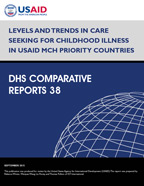- PUBLICATIONS
- JOURNAL ARTICLES
- ACCESS PUBLICATIONS
Publications Summary
- Document Type
- Comparative Reports
- Publication Topic(s)
- Education
- Language
- English
- Recommended Citation
- Winter, Rebecca, Wenjuan Wang, Lia Florey, and Thomas Pullum. 2015. Levels and Trends in Care Seeking for Childhood Illness in USAID MCH Priority Countries. DHS Comparative Reports No. 38. Rockville, Maryland, USA: ICF International.
- Download Citation
- RIS format / Text format / Endnote format
- Publication Date
- September 2015
- Publication ID
- CR38
Download
 Levels and Trends in Care Seeking for Childhood Illness in USAID MCH Priority Countries (PDF, 2187K)
Levels and Trends in Care Seeking for Childhood Illness in USAID MCH Priority Countries (PDF, 2187K)
